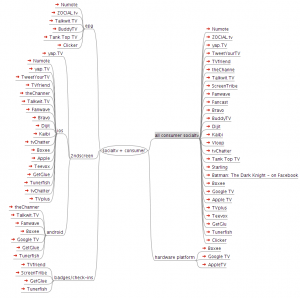Mystery Science Research Lab 2011
It’s my second day at BT’s Future Applications research lab, and I’m sat at my cool 1990’s style ovoid lozenge office desk, doing a broad web-survey of Social TV applications. I’ve just been given my hall pass that allows me in and out of the automatic security doors, each one bearing a sign (in the italic variety of the ubiquitous BT font) saying:
“Please keep noise to a minimum as you walk through this office”.
I’m snorting, wheezing and squeaking with supressed laughter. The researcher sitting opposite me is giving me worried glances, and I can sense heads, peripherally visible over partitions and banks of computer screens, turning and peering in my direction.
![]()
While looking at some prototypes of ‘Avatar Party Mode’, a kind of ‘Virtual Sofa’ service available on the Sky Player foR Xbox Live, I had made the mistake of putting on my headphones and calling up some episodes of one of my favourite late 20th Century TV late-night TV shows, Mystery Science Theatre 3000.
The premise of Joel Hodgson’s MST3K, for the uninitiated, is that as part of an evil scientific experiment, ‘Joel Robinson’ and his robot sidekicks are trapped on a deep-space asteroid and forced to watch B-movies, where, represented as cinema-seated silhouettes at the bottom of the screen, they heckle and wisecrack their way through the film.
I am certainly not the first to make this association. Social TV researchers have turned to MST3K’s presentation style as a model for an acceptable user interface to indicate the co-presence remote viewers and even enable chat-partner selection on the bottom third of a TV screen (Ducheneaut, Moore, Oehlberg, Thornton & Nickell, 2008){{1}}, or as an example of potential applications/services that invite viewers to overlay user generated content and republish personalised video streams over IP (Banerjee et. al., 2002){{2}}. In cultural critique, film and television studies, MST3K has also been invoked as a perfect example of a ‘meta-show’, and used to illustrate how ironic re-appropriation of pop-cultural artefacts can express aesthetic dissent (King, 2007) {{3}}.
The CollaboraTV project implemented this kind of interface as the premise for their ground-breaking Social TV application. They even did some viewer expeience research contrasting this kind of ‘virtual audience’ interface with traditional text-chat underneath video playback, and found that the virtual audience increased audience engagement and enjoyment{{4}}.
In terms of interface, ‘user experience’, and it’s choice of B-movie ‘sociable’ media{{5}}, MST3K seems to offer a useful set of guidelines for Social TV design and research, primarily because the acceptance of it’s visual design and irreverant tone was established when it became a popular cult TV programme. But on a more abstract level, MST3K offers inspirational design patterns for Social TV because of how it constantly shifts focus between the viewer and the viewed, opening up endless imaginative, performative and conversational opportunities.
This shifting of focus foregrounds an aspect of television viewing that is often passed over by cultural critique of the ‘dumbing down’ of TV audiences (Bourdieu & Ferguson, 1998){{6}}. Ien Ang wrote about this in her often-cited book ‘Watching Dallas'{{7}}, where she argues that part of the enjoyment of watching the show for global (in her case Dutch) audiences, far from aspirational identification with the camped-up millionaire Texans, is a smug awareness that ‘other people’ are watching the show in earnest, but that for ‘us’, the show’s tastes and values are an object of collective ridicule. Bad TV, in this way, can be seen as a possible object of counter-identification, forming social groups of collective dislike.
Perhaps a successful deisgn for SocialTV could start with a ‘dislike’ button, and build it’s sociality on the collective activites of booing, heckling and throwing things at the screen.
[[1]]Ducheneaut, N., Moore, R., Oehlberg, L., Thornton, J., & Nickell, E. (2008). Social TV: Designing for Distributed, Sociable Television Viewing. International Journal of Human-Computer Interaction, 24(2), 136-154. doi: 10.1080/10447310701821426. [[1]] [[2]]Banerjee, S., Brassil, J., Dalal, A., & Lee, S.-ju, others. (2002). CDNs for personal broadcasting and individualized reception. In Proceedings of WCW. Citeseer. Retrieved March 29, 2011, from http://citeseerx.ist.psu.edu/viewdoc/summary?doi=10.1.1.7.7964. [[2]] [[3]]King, J. (2011). Mystery Science Theater 3000 , Media Consciousness , and the Postmodern Allegory of the Captive Audience Source : Journal of Film and Video , Vol . 59 , No . 4 ( WINTER 2007 ), pp . 37-53 Published by : University of Illinois Press on behalf of the Univer. Film, 59(4), 37-53. [[3]] [[4]] Harrison, C., & Amento, B. (2007). CollaboraTV: Using asynchronous communication to make TV social again. Adjunct Proceedings of EuroITV2007, 218–222.[[4]] [[5]] In their paper cited above, Ducheneaut, Moore et al. also point to MST3K as a reference point for their observation that some types of content (such as a B-movie) tends to free up people’s attention for more discussion and interaction. [[5]] [[6]]Bourdieu, P., & Ferguson, P. P. (1998). On television and journalism. Pluto Press. [[6]] [[7]] Ang, I. (1985). Watching Dallas: Soap opera and the melodramatic imagination (p. 148). Routledge Kegan & Paul. [[7]]
Mystery Science Research Lab 2011 Read More »

